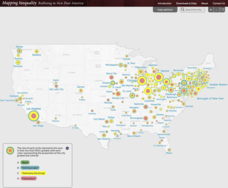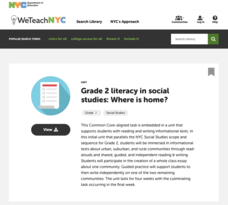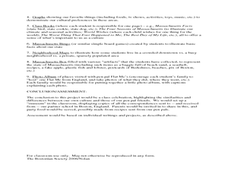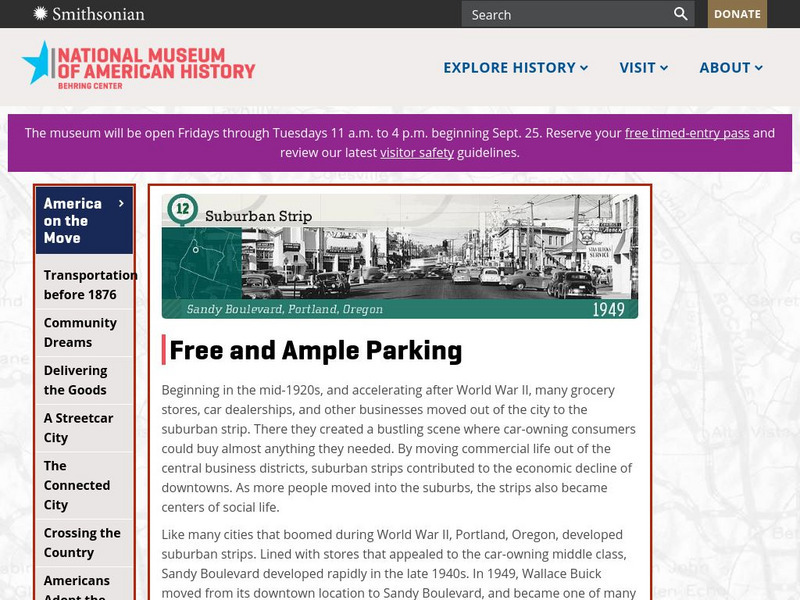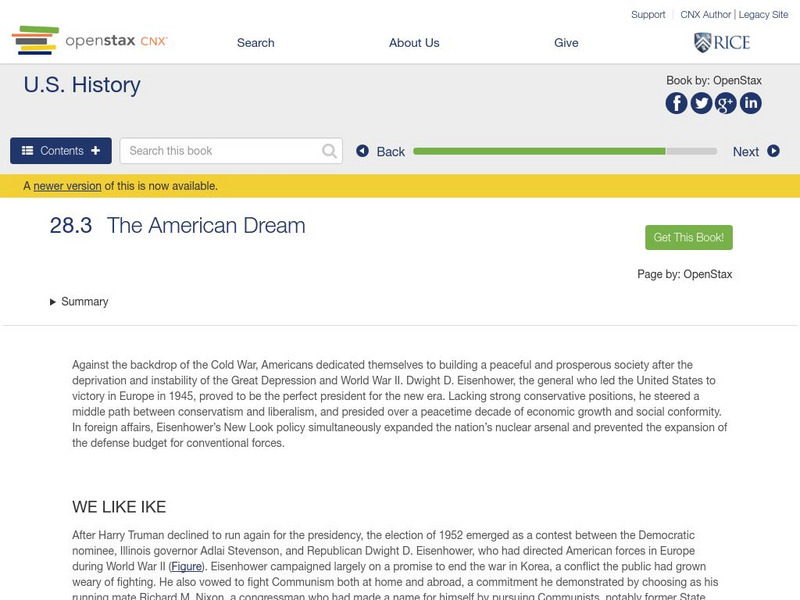University of Richmond
Mapping Inequality: Redlining in New Deal America 1935-1940
Redlining—or the practice of racial discrimination in housing loans—directly led to today's segregated living patterns in America. Using data from the federal Home Owners' Loan Corporation, classmates visualize the impact of policy on...
New York City Department of Education
Grade 2 Literacy in Social Studies: Where Is Home?
What makes a community? How communities differ? Young scholars research different types of communities, small rural towns, and large crowded cities. They respond to writing prompts, and write essays in groups to understand the wide...
Curated OER
Building Suburbia: Highways and Housing in Postwar America
Students determine how suburbs changed America. In this post World War II lesson, students complete research projects that require them to examine the growth of suburbs in the 1950's and 1960's. Students reveal how government policies,...
Curated OER
The 1950s:
Teens will get a kick out of this presentation, which provides a glimpse of the consumerism and rising pop culture of 1950's America. They will especially appreciate the discussion of "Teen culture" including the music of Elvis, the...
Curated OER
You Have to Live in Somebody Else's Country to Understand
Students reflect on emotions commonly expressed by outsiders. They identify feelings of people who have just arrived in America. They read and analyze a poem about immigration.
Compton Unified School District
How Can We Locate Places?
How can we locate places? Maps, of course! Expose second graders to the tools available in maps and discuss how these tools can help people find locations. Students also look at communities, including what makes a community and the...
Annenberg Foundation
Postwar Tension and Triumph
Go get the American Dream lifestyle! The 19th lesson in a 22-part series exploring American history shows learners the post-WWII economic boom. Using primary sources, photographs, and cartoons, groups discuss their findings and present...
Curated OER
Post-War Suburbanization: Causes and Interpretations
In this teaching American history worksheet, students examine a primary source document regarding post-World War II suburbanization. Students discuss their impressions of the document.
Curated OER
Familial Relationships in Great Expectations: The Search for Identity
Students read the novel "Great Expectations" by Charles Dickens. In groups, they use the text to identify and describe family relationships in the book. Using this information, they compare and contrast how these relationships are...
Curated OER
Out of Old England in the 1630s-Flat Me Project
Young scholars write letters to penpals. In this geography/literacy lesson plan, students become penpals with a classroom in England to learn about customs and society across the ocean. Flat Stanley by Will Holton is read aloud, and...
Curated OER
Where In the World is the Dominican Republic?
Students begin the instructional activity by discussing how where they live affects how they live. As a class, they add examples to each category such as home types, clothing, jobs and food. Using those categories, they write about...
Curated OER
Konnichiwa, Welcome To My World
Students create a book about how life is different in America from Japan in order to help a pretend new Japanese student feel welcome.
Curated OER
Is Coming to the United States of America Good for the Immigrant?
Student discuss whether coming to the United States was good for certain groups of immigrants. Using the internet, they examine settlement patterns for immigrants over a period of time. In groups, they role play the role of a family...
Curated OER
Mass Culture: 1950's America
In this 1950's America worksheet, students read 3 article about mass culture and respond to 20 short answer questions.
Curated OER
The Automobile’s Influence on Post-WWII Suburbia
Eighth graders explore post World War II America. In this American History lesson, 8th graders analyze primary and secondary sources to research how the automobile influenced the growth of suburbs, and how the growth of suburbs...
Curated OER
People on the Move
Students explore transportation. In this transportation lesson, students examine the Jupiter locomotive, Washingtion D.C. streetcars, the Leviathan, the Salisbury Train Station, and Route 66. Students respond to 12 questions.
Curated OER
Save Our Soil
Pupils explore the need for good farm land and reasons for the disappearance of agricultural areas. They brainstorm environmental friendly decisions and soil conservation. In their community, students explore new land developments that...
Japan Society
Popular Culture and Japan’s Gross National Cool
From Manga to Godzilla and Pokemon, Japanese pop culture has been taking the globe by storm. This phenomenon is called "soft power." Learners will examine the differences between hard and soft power, as well as learn the historical...
Other
The Suburbanization of America: Patio Culture
This site offers a discussion on middle class suburban life in the 1950's and 1960's which has been dubbed the Patio Culture.
Smithsonian Institution
National Museum of American History: Suburban Strip: Sandy Boulevard, Portland, Oregon 1949
Exhibition focusses on the relationship between transportation and suburbia in the mid 1920s until after World War II when many grocery stores, car dealerships, and other businesses moved out of the city to the suburban strip.
National Endowment for the Humanities
Neh: Edsit Ement: Building Suburbia: Highways and Housing in Postwar America
In this lesson plan, students will consider "Building Suburbia: Highways and Housing in Postwar America." The plan includes worksheets and other student materials that can be found under the resource tab.
C3 Teachers
C3 Teachers: Inquiries: Suburbs
A comprehensive learning module on the suburbanization of America after World War II that includes three supporting questions accompanied by formative tasks and source materials, followed by a summative performance task. Students examine...
OpenStax
Open Stax: Post War Prosperity and Cold War Fears 1945 1960: The American Dream
Looks at the policies of President Dwight D. Eisenhower, both at home and abroad. Also examines changing gender roles in the 1950s, and the impact of suburbanization on America.
Library of Congress
Loc: u.s. History Timeline: The Post War United States 1945 1968
Includes how the United States' entry into WWII caused vast changes in every aspect of American life, how arts and entertainment showed continuity and change, and details of the 1960 election of John F. Kennedy as President.


